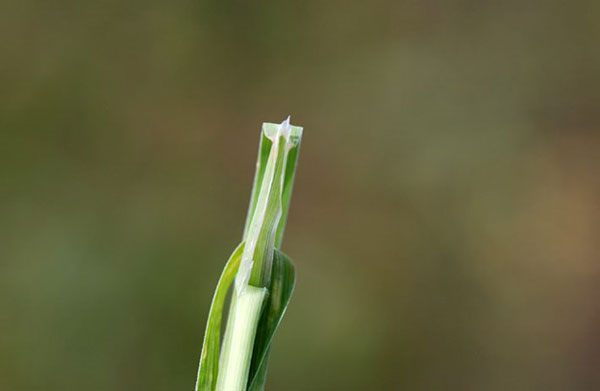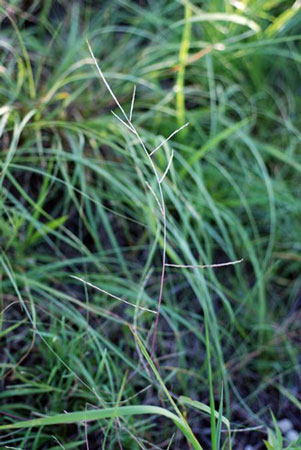Tumblegrass (Schedonnardus paniculatus) is a native perennial grass that can become problematic in no-till fields. Don’t confuse tumblegrass with tumble windmillgrass – another troublesome native perennial grass discussed in a previous World of Weeds article.
Ecology
Tumblegrass (Figure 1) is found throughout Kansas. It can grow in various sites but prefers dry areas with clay or clay loam soils. It is considered an indicator of disturbed soils and is associated with high sodium in the soil. Although it is a perennial, tumblegrass reproduces mainly by seed. Seed heads readily break away at the base like tumble windmillgrass, which facilitates seed dispersal by wind. It is not used by livestock or wildlife.

Figure 1. Tumblegrass growing in a no-till fallow field in Finney County. Note the height of the seed heads in comparison to the height of the leaves. Photo by Logan Simon, K-State Research and Extension.
Identification
Tumblegrass leaves are primarily located near the base of the plant, forming a clump. They are one to six inches long and folded. They are hairless but have a prominent midvein and white margin and may have fine teeth on the margins. Leaf blades become spirally twisted when the plant is mature. The leaf sheaths, loose and crowded at the base, are keeled (folded) with no hairs but have membranous margins. The ligule is also membranous and is continuous with the sheath margin. (Figure 2) This feature distinguishes it from tumble windmillgrass, which has a hairy ligule.

Figure 2. Tumblegrass ligule is membranous and connected to the margins of the leaf sheath. Photo by Mike Haddock, kswildflower.org.
The arched culm (stem) gets longer between flowering and seed maturity. Seed heads are loosely spiraled panicles two to 24 inches long (more than half the height of the plant). Panicles comprise three to 13 wide-spaced, spike-like branches that are slightly curved when mature (Figure 3).

Figure 3. Widely-spaced, slightly curved, spike-like branches of tumblegrass. Photo by Mike Haddock, kswildflower.org.
Management
Little information is available on controlling tumblegrass. It can be inferred from some research that tumblegrass will tolerate applications of glyphosate and chlorsulfuron (Glean). Grazing has limited effectiveness as a management tactic due to being unpalatable. Fire is also not likely to be effective because, being native to the Plains, tumblegrass is a fire adapted species.
An upcoming article will address the best management options for warm-season perennial grasses. Stay tuned!
The use of trade names is for clarity to readers and does not imply endorsement of a particular product, nor does exclusion imply non-approval. Always consult the herbicide label for the most current use requirements. Users should read and follow all label instructions.
Sarah Lancaster, Extension Weed Management Specialist
slancaster@ksu.edu
Logan Simon, Southwest Area Agronomist
lsimon@ksu.edu
Jeremie Kouame, Weed Scientist – Agricultural Research Center, Hays
jkouame@ksu.edu